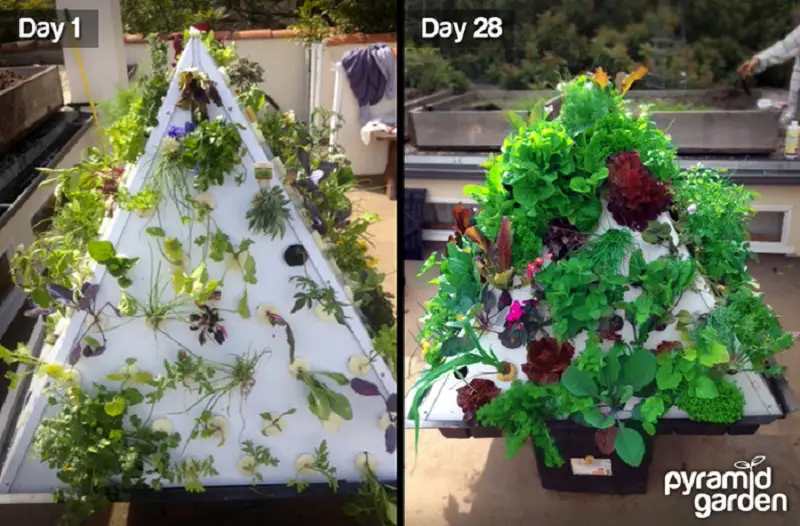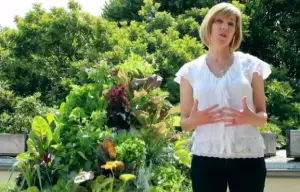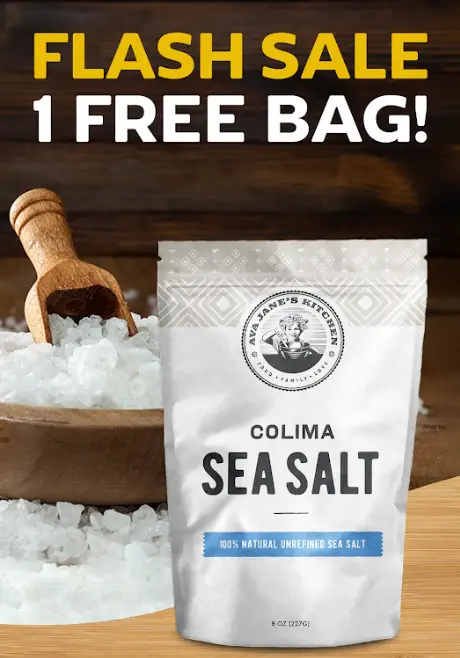With more and more people seeking access to fresh organic fruits and vegetables, new and more creative solutions have also begun popping up.
Regular straight up-and-down personal vertical gardening systems are one of the most exciting innovations, allowing people in urban areas and those without much land to still grow a ton of organic produce.
These tower gardens have a bright future, but there’s always room for more innovation, and that’s where the PyramidGarden comes in.
The ambitious start-up project, an aeroponic vertical growing system in a more efficient pyramid shape, offers aspiring next-gen green thumbs the ability to grow up to 136 plants at once in a mere 4 foot by 4 foot space, for 32 sq. feet total of growing space.
The PyramidGarden still needs help to reach its Kickstarter goal of $45,000, though, in order to get off the ground; you can help them out with donations of any amount you can afford by clicking on this link and donating before the end of the campaign which happens July 23.
Should the launch go as planned, this particular product could help many people grow their own food more efficiently. The PyramidGarden’s design allows a more even distribution of sunlight compared to other systems with flat, vertical sides, and works for growing herbs, vegetables and flowers with no soil needed.
In order to learn more about the PyramidGarden and how it could potentially help more people grow their own food, even in tight spaces, I conducted the following interview with inventor Allan Murr, enjoy!:
NM: How did the idea for the PyramidGarden come about and what makes it so unique?
AM: The idea for the PyramidGarden was a realization during a heavy snow fall one day. I was experimenting with hydroponics in my basement. I was tending to my lettuce realizing that I was very lucky that I was able to feed my family fresh vegetables from the basement. I had thought there must be a way to take this commercially.
After researching a bit on vertical hydroponics, I was not happy with what I saw on the market. I was looking for a system that would produce a lot of yield while not taking too much space. The napkin idea eventually developed into the PyramidGarden.
NM: We’ve been hearing a lot about tower gardens and similar products, how does your product differ from them them?
AM: One of the differences is the growing area and capacity of plants you can grow. Both products are considered aeroponics. I believe that the PyramidGarden has a better capacity to produce more oxygen to the root level by producing a nutrient enriched mist.
The PyramidGarden has the advantage of growing root vegetables. The interior of the pyramid design allows for a fantastic environment for root growth.
NM: Please explain the inner workings of the garden, is it easier to tend and use than a regular garden?
AM: There are various forms of hydroponics. The PyramidGarden is an aeroponic planter system. That means the roots are growing in air and nutrient water is misted onto the roots. This method creates an oxygen enriched environment that roots love. One of the great things about hydroponics altogether, is the lack of weeding and watering. Growing hydroponically is a science and a hobby if you want it to be.
When it comes right down to it, you need to know what is in your nutrient water growing hydroponically, or what’s in your soil for conventional gardening. The latter is harder to do. You can create the best compost ever, however you still wont know what’s in your soil for your base elements. With hydroponics, you can control what raw elements are in your system. As long as you don’t use synthetic nutrients!
NM: How does the food grown through this aeroponics based system compare nutritionally to a regular garden, and are there any studies that have been done in this field? It seems there are some who are believers in aeroponics and others who aren’t, what would you tell the non-believers quote-unquote?
AM: This is where there are a lot of unknowns to the non-believers. It’s all education if you want to hear about it. Hydroponics has been around since the days of Babylon. Two things stand in the way of non-believers. There is a stigma with hydroponics which is marijuana growing. Also, the term “organic” has been successfully deemed as the ultimate method of growing. Ask anyone, “what does organic mean to you?” I have many times.
People are stumped by my simple question. They would typically say, “Well….plants that are not sprayed with pesticides, fungicides, dyes, etc.”
For most people, I have determined that the word “organic” is a safety word. Nothing wrong with that. In our hectic lives, we go to the supermarket to get the healthiest product and the easiest thing to do is look for “organic”. Bottom line, if you grow a healthy plant, the more nutritious the product will be.
Growing hydroponically has been proven to grow healthier plants in a lot of cases over conventional growing.
NM: How do you believe the garden could benefit the economically disadvantaged especially?
AM: This is where PyramidGarden really stands out. We have already been contacted by three different groups that want to work with us. They understand that it would be relatively easy, due the its large growing capacity, to combine as many PyramidGardens as necessary and empower people by affording them the opportunity to grow their own nutritious and inexpensive food. Because it doesn’t need a constant water source or soil and can be used indoors it can be used just about anywhere.
NM: Is this garden something that could be of particular use to native people, like, let’s say, the Inuit of Alaska or example? And if so, why, and do you believe they will be able to afford it?
AM: I believe the PyramidGarden would be very useful to various native people. In a lot of cases, First Nations people live in harsh areas where growing plants is only a dream. By growing indoors and using grow lights, people would be able to grow nutritious vegetables that are so needed in their diet. I can’t wait to be part of the first indoor PyramidGarden farm in the northern communities.
I believe that this system is affordable in comparison to the cost of shipping food up there.
My understanding is that can cost $14 for a frozen head of iceberg lettuce (in Inuit areas).
Not nutritional at all! Here is an example. If they were to buy 40 heads of frozen lettuce, that would cost $560.00!
That’s more than the price of a PyramidGarden. How can they afford not to?
NM: What types of plants and food will it be able to grow…?
AM: The PyramidGarden will be able to grow a lot of different types of vegetables, herbs and flowers. In our tests, we have grown various lettuces, root vegetables, basil, strawberries, tomatoes, broccoli, chard, bok choy, etc. It has been wonderful to see various plants grow in the system.
Most importantly, the amazing tastes my family has been experiencing. My kids are now fussy for what I grow. They can tell the difference of what has been bought at the market compared to what daddy grew!
NM: Give us the targeted specs of your product, how much will it cost and what options will be offered?
AM: After the Kickstarter campaign a unit will cost between $425-450 which will include nutrients, pucks, baskets.
Options on the drawing board are smaller models, models that rotate and solar units.
NM: Where is the PyramidGarden in its development phase, are you planning to roll it out commercially soon? Also, tell us about your Kickstarter campaign and how people can help support the project, and why they should.
The prototype is finished and operational. Refinements have been implemented to make assembly faster, the filtration and spraying unit more efficient and access to the inside and reservoir easier.
We are just waiting for funding to begin production. By funding this project and obtaining a PyramidGarden, not only will they and their family benefit by taking control of what they eat and more importantly what they don’t eat but on a large scale can help reduce water consumption dramatically.
NM: Thanks for joining us, and best of luck with the project!
AM: Thank you for having me.
Reminder: The PyramidGarden Kickstarter campaign mentioned above is running through July 23, you can help support the project by clicking on this link.
Thanks for installing the Bottom of every post plugin by Corey Salzano. Contact me if you need custom WordPress plugins or website design.













